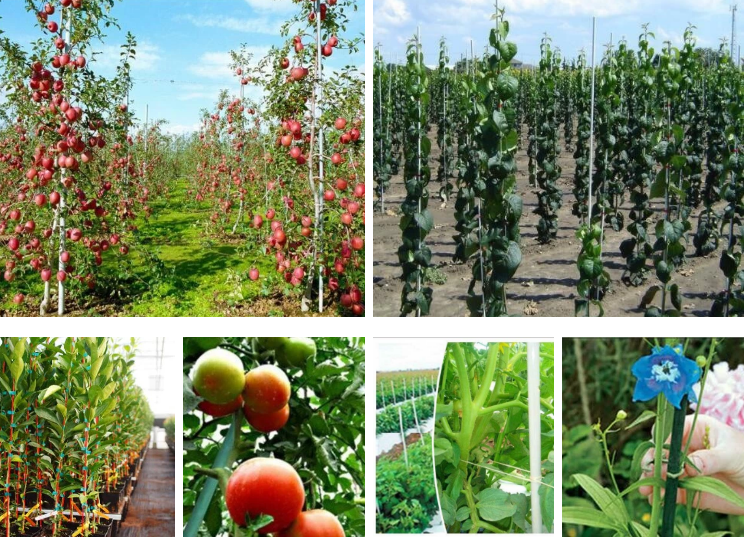How to Use Fiberglass Plant Stakes for Your Garden: A Complete Guide
Gardening enthusiasts are always on the lookout for innovative and reliable tools to support the growth of their plants. One such tool that has gained popularity in recent years is the fiberglass plant stake. In this comprehensive guide, we will explore the ins and outs of using fiberglass plant stakes in your garden, covering everything from advantages and types to installation techniques and creative applications.

I. Introduction
A. Brief Explanation of Fiberglass Plant Stakes
Fiberglass plant stakes are sturdy, lightweight rods designed to support plants as they grow. Unlike traditional stakes made of wood or metal, fiberglass stakes offer a range of benefits that make them a preferred choice among gardeners.
B. Importance of Using Fiberglass Plant Stakes in Gardening
The right support can make a significant difference in the health and appearance of your plants. Fiberglass stakes provide the stability and flexibility needed for various plant types, ensuring they thrive in any garden environment.
II. Advantages of Fiberglass Plant Stakes
A. Durability and Longevity
Fiberglass stakes are known for their exceptional durability, outlasting traditional stakes that may succumb to rot or rust. This longevity ensures reliable support for your plants throughout their growth.
B. Flexibility and Resistance to Weather Conditions
Gardeners often face unpredictable weather conditions. Fiberglass stakes, with their inherent flexibility, can withstand strong winds and bending without breaking, offering continuous support in changing climates.
C. Lightweight and Easy Handling
Maneuvering heavy stakes can be a hassle, especially in larger gardens. Fiberglass stakes are lightweight, making them easy to handle during installation and adjustments as your plants grow.
III. Types of Fiberglass Plant Stakes
A. Standard Straight Stakes
The most common type, straight fiberglass stakes, provide basic support for a variety of plants. They are versatile and suitable for both indoor and outdoor gardening.
B. Coated Stakes for Added Protection
Some fiberglass stakes come with protective coatings, enhancing their resistance to UV rays and other environmental factors. These coated stakes offer extended durability, especially in sunny or harsh climates.
C. Color-Coded Stakes for Plant Organization
For meticulous gardeners, color-coded fiberglass stakes offer a visual aid in organizing different plant varieties. This not only adds a touch of organization to the garden but also simplifies maintenance.
IV. Choosing the Right Fiberglass Plant Stake
A. Considering Plant Types and Sizes
Different plants have varying support needs. Understanding the growth patterns and potential size of your plants helps in selecting the right height and thickness of fiberglass stakes.
B. Understanding Soil and Weather Conditions
Soil composition and local weather play a crucial role in the effectiveness of plant stakes. Choosing stakes that are compatible with your soil type and weather conditions ensures optimal support.
C. Budget-Friendly Options
While fiberglass stakes offer long-term value, it's essential to consider your budget. Fortunately, there are cost-effective options without compromising on quality, making fiberglass stakes accessible to all gardeners.
V. Proper Installation Techniques
A. Digging the Right Hole Size
The foundation of a stable plant stake is a properly sized hole. Digging a hole that matches the stake's diameter ensures a snug fit, preventing wobbling and potential damage to the plant.
B. Securing the Plant to the Stake
Tying your plant to the stake requires attention to detail. Using soft materials and adjustable ties allows for secure yet gentle support, preventing damage to the plant's stems or branches.
C. Adjusting the Stake as the Plant Grows
Plants evolve, and so should their support. Regularly check the stake's height and adjust it accordingly as your plant grows, providing continuous and effective support throughout its development.
VI. Maintenance Tips
A. Cleaning and Storing Fiberglass Stakes
Maintaining the cleanliness of your stakes ensures longevity. Periodically clean off dirt and debris, and store stakes in a dry place to prevent damage and prolong their lifespan.
B. Checking for Damages and Wear
Regular inspections are vital to identifying any signs of wear or damage. Cracks, splinters, or weakened areas should prompt immediate replacement to avoid compromising the support structure.
C. Reusing Stakes for Multiple Seasons
Fiberglass stakes are a sustainable option. When properly maintained, they can be reused for multiple seasons, contributing to both environmental conservation and cost savings.
VII. Common Mistakes to Avoid
A. Overlooking the Importance of Stake Height
Incorrect stake height can lead to inadequate support, affecting the plant's growth and stability. Always consider the plant's expected height and choose stakes accordingly.
B. Neglecting the Need for Regular Checks
Assuming your stakes are set and forget can result in unforeseen issues. Regularly check your stakes for stability and adjust them as needed, especially during periods of rapid plant growth.
C. Using the Wrong Type of Stake for Specific Plants
Not all plants have the same support requirements. Using the wrong type of stake can hinder growth and potentially damage delicate plants. Always match the stake to the plant's needs.
VIII. Creative Uses of Fiberglass Plant Stakes
A. DIY Trellises and Supports
Fiberglass stakes are not limited to basic support. Get creative by using them to build trellises or customized supports for climbing plants, adding an artistic touch to your garden.
B. Creating Decorative Garden Structures
Beyond functionality, fiberglass stakes can serve an aesthetic purpose. Incorporate them into garden structures, such as archways or decorative fencing, enhancing the overall visual appeal of your outdoor space.
C. Enhancing Plant Aesthetics with Stakes
Use fiberglass stakes strategically to showcase your plants. Arrange them in patterns or groupings to highlight specific areas of your garden, turning simple stakes into decorative elements.
X. Environmental Impact of Fiberglass Stakes
A. Comparing Fiberglass to Traditional Materials
Evaluate the environmental impact of fiberglass stakes compared to traditional materials like wood or metal. Consider factors such as resource depletion, energy consumption, and overall sustainability.
B. Recycling and Eco-Friendly Options
Gardening can be eco-friendly, and so should your tools. Explore recycling options for fiberglass stakes and discover eco-friendly alternatives that align with sustainable gardening practices.
C. Sustainable Gardening Practices
Extend the eco-conscious approach beyond stakes. Learn about sustainable gardening practices that contribute to environmental conservation, creating a harmonious balance between your garden and nature.
XI. Frequently Asked Questions (FAQs)
A. Are Fiberglass Stakes Suitable for All Plant Types?
Yes, fiberglass stakes are suitable for a wide range of plant types, providing versatile support for both indoor and outdoor plants.
B. Can Fiberglass Stakes Be Painted for Customization?
Certainly! Fiberglass stakes can be painted to match your garden's aesthetic. Ensure the paint used is suitable for outdoor applications.
C. What's the Average Lifespan of Fiberglass Plant Stakes?
With proper care, fiberglass stakes can last for several seasons, offering long-term support to your plants.
D. Are There Any Safety Considerations When Using Fiberglass Stakes?
Fiberglass stakes are generally safe to use. However, wear gloves during installation to avoid splinters, and check for any sharp edges before securing your plants.
E. How Do Fiberglass Stakes Compare to Bamboo or Metal Stakes?
Fiberglass stakes outperform bamboo and metal stakes in terms of durability, flexibility, and overall longevity. They are a reliable choice for various gardening needs.
XII. Conclusion
In conclusion, incorporating fiberglass plant stakes into your gardening routine can revolutionize the way you support and showcase your plants. The durability, flexibility, and creative potential of these stakes make them a valuable addition to any garden. Whether you're a novice or an experienced gardener, exploring the possibilities of fiberglass stakes can elevate your gardening experience to new heights.

